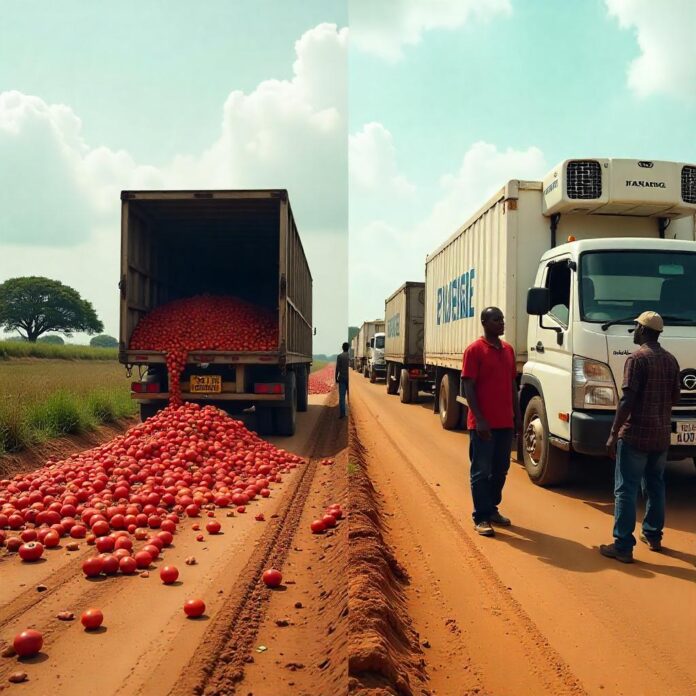The Silent Crisis on Our Farms
Picture this: 40% of the food grown by Nigerian farmers vanishes before reaching consumers—enough to feed 40 million people annually. This isn’t a hypothetical scenario; it’s Nigeria’s daily reality, draining ₦3.5 trillion from our economy yearly. For smallholder farmers in Kano or Lagos, this means backbreaking labor literally rotting on trucks or in fields. Agriculture employs over 35% of Nigerians, yet we lose more to spoilage than the federal agriculture budget for five consecutive years.
This crisis isn’t just about money. It’s about empty plates, malnourished children, and farmers trapped in debt. As Alexander Isong of the Organisation for Technology Advancement of Cold Chain in West Africa states: Cold chain infrastructure isn’t luxury; it’s about nutrition, food safety, and national survival. Let’s dissect why our food vanishes and how we can turn waste into wealth.
The N3.5 Trillion Black Hole: Quantifying the Crisis
Crop-Specific Carnage
Fruits & Vegetables: 45-50% lost (13.9 million tons produced yearly) – equivalent to ₦1.2 trillion.
Fish & Seafood: 35% spoilage due to reliance on traditional smoking methods – ₦450 billion gone.
Cereals & Tubers: 30% loss (maize, rice, cassava) – draining ₦900 billion annually.
Economic Shockwaves
This ₦3.5 trillion hemorrhage exceeds the combined budgets of seven Nigerian states.
Represents 10% of Nigeria’s GDP – more than the entire education or healthcare allocation.
Agricultural export potential remains stunted at $2 billion/year vs. a possible $10 billion with cold chains.
| Commodity | Loss Rate | Economic Value Lost | Human Impact |
|---|---|---|---|
| Fruits & Vegetables | 45-50% | ~₦1.2 trillion | Feeds 15M+ people |
| Fish & Seafood | 35% | ~₦450 billion | Protein deficit for coastal communities |
| Cereals & Tubers | 30% | ~₦900 billion | Staple foods for 20M households |
| Dairy & Meat | 30%+ | ~₦950 billion | Lost nutrition for children |
Why Food Vanishes: Root Causes of Post-Harvest Losses
The Cold Chain Catastrophe
Nigeria’s temperature control infrastructure is nearly non-existent: Only 5% of perishables move via refrigerated transport. Cold storage facilities meet less than 10% of farmer needs. As Alexander Isong bluntly states: Nigeria is next to zero—we have minute cold rooms that don’t scratch the surface.
Logistical Nightmares
Rural roads are impassable during rains, delaying produce delivery. 90% of perishables travel in open trucks, baking under the sun and soaking up pollutants.
Energy Poverty & Tech Gaps
80% of rural farms lack grid electricity, making refrigeration impossible. Basic tools like moisture meters or hermetic bags remain inaccessible to smallholders.
Policy Paralysis
No national cold chain strategy exists, with roles fragmented across agencies. Tax/funding incentives for cold chain investors are absent despite 40% annual losses.
Beyond Economics: The Human & Environmental Toll
The Hunger Paradox
While 25 million Nigerians face acute hunger, 50% of harvested food rots before reaching markets. As a Kano tomato farmer lamented: We work hard, but our harvests rot before buyers arrive.
Farmer Despair
Smallholders lose 40% of annual income to spoilage, trapping families in debt cycles. Without cooperatives, farmers lack bargaining power to demand cold storage.
Environmental Time Bomb
Rotting food emits methane—25x more potent than CO₂—accelerating climate change. Lagos alone dumps 13,000 tons of daily waste, mostly organic spoilage clogging drains and fueling floods.
Turning the Tide: Proven Solutions in Action
Cold Chain Revolution
Solar-Powered Cold Hubs: Companies like Ecotutu deploy solar chillers, extending produce shelf life by 21 days via pay-as-you-store models. Polar Store (Netherlands-Lagos partnership) slashes losses by 80% for 5,000 farmers. Mobile Refrigeration: Solar-powered reefer trucks reduce transit spoilage, especially for fish and dairy.
Tech & Innovation Leaps
E-oracle Digital Trackers: Real-time monitoring of temperature/humidity during transit (NSPRI pilots show 65% less grain spoilage). Edible Packaging: Biodegradable materials replace plastic (e.g., Crown Flour Mill’s initiatives) to cut waste and contamination.
Policy Shifts That Work
Government Actions: Tax breaks for cold chain investors (proven to boost ROI by 30%). National cold chain policy aligning with Malabo Declaration targets. Private Sector Opportunities: $10 billion/year export potential by meeting Global G.A.P./ISO 22000 standards.
| Metric | Current Status | Potential (5 Years) |
|---|---|---|
| Farmer Income | 40% loss-driven deficit | 50% increase |
| Food Waste | 40% of harvest | Less than 15% |
| Agricultural Exports | $2 billion/year | $10 billion/year |
| Carbon Emissions | High methane from waste | 30% reduction |
Success Stories: Models That Work
Ecotutu’s Pay-As-You-Chill: “Our solar cold rooms cut spoilage for 12,000 Lagos traders by 70%, boosting incomes 40%.” — Adejoke Nofiu, Ecotutu Head of Operations. OTACCWA’s Training Hub: Trained 3,000 farmers in cold storage management, reducing losses by 83% for participants. Netherlands-Lagos Polar Store: Solar-powered storage + training combo helping farmers preserve tomatoes and peppers.
Your Role in the Solution
Policymakers & Government
Prioritize cold chains as critical infrastructure (like roads or ports). Allocate 15% of agricultural budgets to post-harvest tech subsidies.
Businesses & Investors
Fund solar cold storage—ROI hits 30% via loss reduction. Partner with startups like Ecotutu for scalable impact.
Citizens & Communities
Buy OTACCWA-certified produce to support ethical cold chains. Demand edible packaging from retailers to reduce plastic waste.
From Waste to Wealth
Nigeria’s ₦3.5 trillion post-harvest loss is a solvable crisis. By scaling solar cold chains, adopting smart packaging, and enforcing targeted policies, we can transform rotting harvests into wealth—feeding millions, empowering farmers, and slashing emissions. As Lagos Agriculture Commissioner Abisola Olusanya asserts: Collaboration between government, innovators, and communities is non-negotiable.


